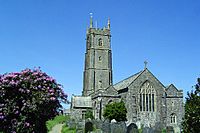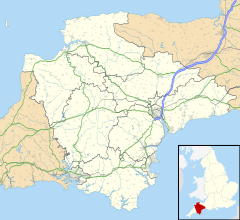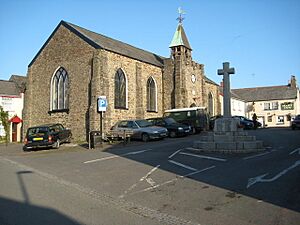Hartland, Devon facts for kids
Quick facts for kids Hartland |
|
|---|---|
| Population | 1,724 |
| OS grid reference | SS2524 |
| District |
|
| Shire county | |
| Region | |
| Country | England |
| Sovereign state | United Kingdom |
| Post town | BIDEFORD |
| Postcode district | EX39 |
| Dialling code | 01237 |
| Police | Devon and Cornwall |
| Fire | Devon and Somerset |
| Ambulance | South Western |
| EU Parliament | South West England |
| UK Parliament |
|
Hartland is a village in Devon, England. It's the most north-westerly place in the county and includes smaller areas like Stoke and Meddon.
Today, Hartland is a large village that serves the surrounding countryside and attracts some tourists. But long ago, during the Tudor period, it was a very important port. It's near Hartland Point, a place where the coast changes direction, from facing the Bristol Channel to the Atlantic Ocean. There's a big lighthouse there that helps ships. The old harbour, called Hartland Quay, is south of the point. It was first built in the late 1500s but was destroyed by the sea in 1887. The tall tower of the Church of Saint Nectan in Stoke is still a useful landmark for ships in the Bristol Channel. In 2011, the population of the Hartland area was 3,019 people.
Contents
Getting Around Hartland
Hartland is a great spot for walking along parts of the South West Coast Path. The wild and beautiful scenery around Hartland Point is some of the most amazing on the whole path. You can even see Lundy Island from here!
If you want to visit Lundy Island, a company runs a helicopter service from Hartland Point between November and March. There are also bus services, like the 319, which goes from Barnstaple to Hartland and back. Another bus, the 519, can take you to Bude.
Hartland's Past and Famous Buildings
In the past, Hartland was known as Harton. It was an old type of town called a "borough" until 1886. In medieval times, there was an important abbey in Hartland where people came to honour a saint named St Nectan. Hartland Abbey and the main church are about 2 miles away in Stoke.
Hartland Abbey's Story
Hartland Abbey Hartland Abbey was built in 1157 and officially opened in 1160. It became an Augustinian abbey in 1189. In 1539, it was the very last monastery to be closed down by King Henry VIII. The King then gave the building to William Abbot, who worked for him at Hampton Court.
William Abbot turned the part of the abbey where the Abbot used to live into a large house. The house you see today still has some parts from the Tudor period, but most of it is a new section added in 1705. More changes were made around 1860. The beautiful gardens around the abbey were designed by a famous garden designer named Gertrude Jekyll.
Churches of Hartland

Saint Nectan was a holy man from the 5th century who lived in Stoke. The main Church of England church here is St Nectan's Church, Stoke, Hartland. There was also a Roman Catholic church dedicated to St Nectan, which opened in 1964. However, it closed in 2010 because there were no priests available, and it was taken down in 2012.
The Parish Church of St Nectan has the tallest church tower in all of Devon, standing 128 feet high! This large church, which is 137 feet long, was built in the mid-1300s. Inside, you can see a beautiful old font from Norman times and a very impressive wooden screen. The church also has old wagon-style roofs and interesting monuments, including a medieval tomb.
Historic Family Homes
Some important historic family estates within the Hartland area include:
- Docton
What's in a Name?
The name "Hartland" probably comes from an old English word, "heort," which means deer. It's surprising that this name isn't more common in England! Many other places around the world called Hartland likely got their name from this important English village. Before America was discovered, the word "Hart" was common in surnames, like "Hartshorne." The nearby Hartland Point was even called "promontory of Hercules" by the Romans, which might have influenced the name of the village later on.
Fun Facts About Hartland
Twin Town Hartland is twinned with Plozévet in Brittany, France. This means they are like sister towns and often share cultural exchanges.
Nature and Science The coast around Hartland is part of the North Devon Coast Area of Outstanding Natural Beauty (AONB). This means it's a special place with beautiful natural scenery. The British Geological Survey also has a magnetic observatory (a place that studies Earth's magnetic field) just north of Hartland.
Hartland on TV You might have seen Hartland on television!
- In 2008, some scenery and a cottage on the Hartland Abbey estate were shown in the BBC show Sense and Sensibility.
- In 2016, an episode of the BBC's The Night Manager featured Hartland's main street (Fore Street), Hartland Quay, and the same cottage from Hartland Abbey.
Local Magazines The Hartland Times was a magazine that reported on village life from 1981 to 2014. It was inspired by an older local newspaper called the Hartland Chronicle. After the Hartland Times stopped, a new magazine called the Hartland Post started in 2015/16 and is published every three months.
Famous People from Hartland
- Mary Norton, who wrote the famous Borrowers books, lived in Hartland towards the end of her life. She is buried at the local parish church in Stoke.
- Satish Kumar is an editor of Resurgence magazine and started the Small School in Hartland.
|
See also
 In Spanish: Hartland (Devon) para niños
In Spanish: Hartland (Devon) para niños



